
These data indicate that S. aureus is a(n)
a. Mesophile
b. Facultative anaerobe
c. Facultative halophile
d. Aerobe
e. Halophile
c. Facultative halophile
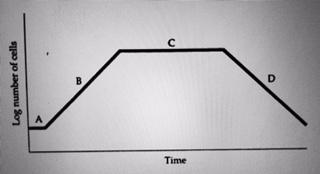
Which section shows a growth phase where the number of cells dying equals the number of cells dividing?
a. A
b. B
c. C
d. D
e. A and C
c. C
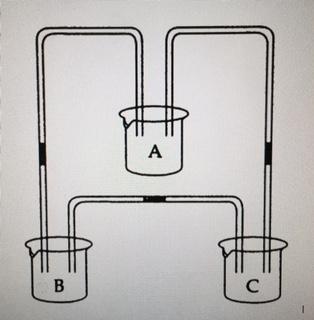
When the experiment is set up, the initial movement of water will be
a. A to B; B to C; C to A
b. A to B; C to B; C to A
c. A to C; B to C; C to A
d. A to C; C to B; C to A
e. B to A; B to C; C to A
b. A to B; C to B; C to A
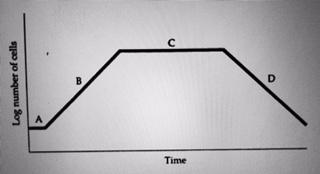
Which sections of the graph illustrate a logarithmic change is cell numbers?
a. A and C
b. B and D
c. A and B
d. B and D
e. B only
b. B and D
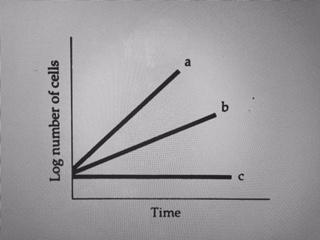
Which line depicts the growth of an anaerobe in the presence of O2?
C
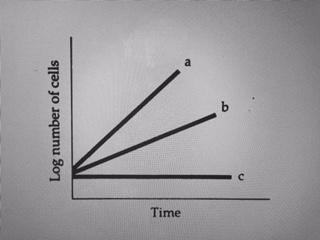
Which line depicts the growth of a mesophile with an optimum temperature of 35°C incubated at 40°C?
B
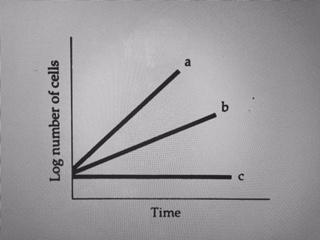
Which line illustrates the growth of a facultative anaerobe incubates aerobically?
C
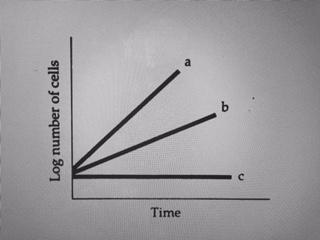
Which line best depicts a catalase-negative cell incubates aerobically?
C
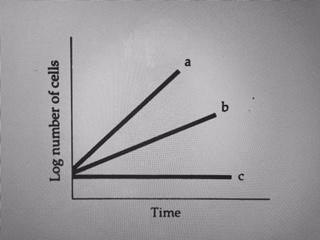
Which line depicts the growth of a facultative anaerobe in the absence of O2?
B
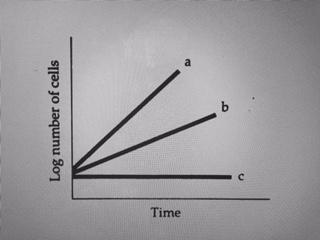
Which line best illustrates a mesophile at 5°C above its optimum temperature?
B
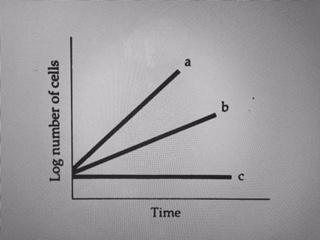
Micrococci are facultative halophiles. Which line best depicts the growth of M. luteus in a nutrient medium containing 7.5% NaCl
B
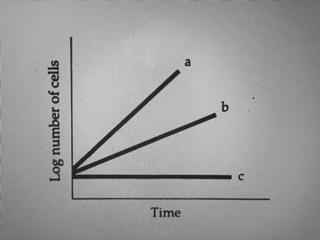
Which line best depicts a psychrophile incubated at room temperature?
C
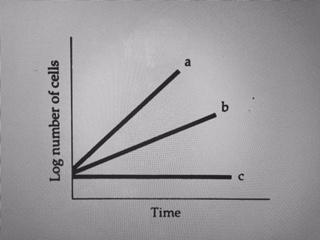
Which line best depicts a psychrotroph incubated at 0°C?
B
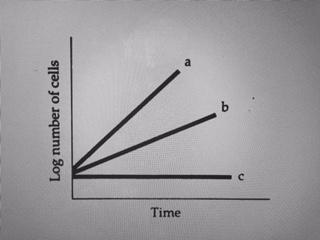
Which line best depicts Neisseria gonorrhoeae when growing inside the human body?
A
Which of the following should not be included in a medium used to select for a nitrogen-fixing chemoheterotroph?
a. KH₂PO₄
b. (NH₄)₂SO₄
c. Glucose
d. MgSO₄
e. Na₂HPO₄
b. (NH₄)₂SO₄
Catalyzes the reaction: O2 - + O2 - + 2H+ → H2O2 + O2
a. Catalase
b. Oxidase
c. Perioxidase
d. Superoxide dismutase
e. None of the above
d. Superoxide dismutase
Catalyzes the reaction: 2H2O2 → 2H2O + O2
a. Catalase
b. Oxidase
c. Perioxidase
d. Superoxide dismutase
e. None of the above
a. Catalase
Catalyzes the reaction: H2O2 + 2H+ → 2H2O
a. Catalase
b. Oxidase
c. Perioxidase
d. Superoxide dismutase
e. None of the above
c. Perioxidase
The source of nutrients in nutrient agar is
a. Agar
b. Nutrient.
c. Peptone and beef extract.
d. Peptone and NaCl.
e. All of the above
c. Peptone and beef extract.
Assume you inoculated 100 cells into 100 ml of nutrient broth. You then inoculated 100 cells of the same species into 200 ml of nutrient broth. After incubation for 24 hours, you should have
a. More cells in the 100 ml.
b. More cells in the 200 ml.
c. The same number of cells in both
c. The same number of cells in both

Which medium (media) is (are) chemically defined?
a. A
b. B
c. A and B
d. A and C
e. None of the above
a. A

On which medium would an autotroph grow?
a. A
b. B
c. A and B
d. A and C
e. None of the above
a. A
This organism produces caltase and superoxide dismutase
a. Aerobe
b. Aerotolerant anaerobe
c. Obligate anaerobe
a. Aerobe
This organism is killed by atmospheric O2
a. Aerobe
b. Aerotolerant anaerobe
c. Obligate anaerobe
c. Obligate anaerobe
Producers in the hydrothermal vents in the ocean floor use CO2 for their carbon source and what for energy?
a. Light
b. Sulfide
c. Organic molecules
d. Carbon dioxide
e. None of the above
b. Sulfide
Three cells with generation times of 30 minutes are inoculates into a culture medium. How many cells are there after 5 hours?
a. 3 x 210
b. 1024
c. 243
d. 48
e. 16
a. 3 x 210
An experiment began with 4 cells and ended with 128 cells. How many generations did the cells go through?
a. 64
b. 32
c. 6
d. 5
e. 4
d. 5
Which of the following is an example of a metabolic activity to measure microbial growth?
a. Standard plate count
b. Glucose consumption
c. Direct microscope count
d. Turbidity
e. MPN
b. Glucose consumption
Which of the following is an organic growth factor?
a. Glucose
b. NAD+
c, Peptone
d. NH4H 2PO4
e. All of the above
b. NAD+
Which group of organisms is most likely to spoil freshwater trout preserved with salt?
a. Psychrophiles
b. Halophiles
c. Anerobes
d. Thermophiles
e. None of the above
b. Halophiles
All of the following are direct methods to measure microbial growth except
a. Direct microscope count
b. Standard plate count
c. Filtration
d. Metabolic activity
e. MPN
d. Metabolic activity
Which of the following is the best definition of generation time?
a. The length of time it takes for lag phase.
b. The length of time for a cell to divide.
c. The minimum rate of doubling.
d. The duration of log phase.
e. The time it takes for nuclear division.
b. The length of time for a cell to divide.
During which growth phase will gram-positive bacteria be most susceptible to penicillin?
a. Lag phase
b. Log phase
c. Death phase
d. Stationary phase
e. The culture is equally susceptible during all phases.
b. Log phase
Which of the following pairs is mismatched?
a. Psychrotroph--growth at 0°C
b. Thermophile--growth at 37°C
c. Mesophile--growth at 25°C
d. Psychrophile--growth at 15°C
e. None of the above
b. Thermophile--growth at 37°C
A culture medium consisting of agar, human blood, and beef heat is a
a. Chemically defined medium
b. Complex medium
c. Differential medium
e. Reducing medium
b. Complex medium
A culture medium on which only gram-positive organisms grow and a yellow halo surrounds Staphylococcus aureus colonies is called a(n)
a. Selective medium
b. Differential culture
c. Enrichment culture
d. A and B
e. B and C
d. A and B
Most bacteria grow best a pH
a. 1
b. 5
c. 7
d. 9
e. 14
c. 7
Thirty-six colonies grew in nutrient agar from 1.0 ml of undiluted sample in a standard plate count. How many cells were in the original sample?
a. 4
b. 9
c. 18
d. 36
e. 72
d. 36
Which of the following is not a disadvantage of the direct microscopic count?
a. Some organisms are motile
b. Enumerates dead cells
c. No incubation time
d. Sample volume is unknown
e. Large number of cells is requires
c. No incubation time
Which of the following is not used to determine metabolic activity?
a. Acid production from fermentation
b. CO2 produced from the Krebs cycle
c. NO- 2 produced from the electron transport chain
d. Decreased dissolved oxygen
e. Turbidity
e. Turbidity
Which of the following is not a disadvantage of the standard plate count?
a. Cells may form aggregates
b. Requires incubation time
c. Determines viable cells
d. Chemical and physical requirements are determined by media and incubation
e. None of the above
c. Determines viable cells
The term facultative anaerobe refers to an organism that
a. Doesn't use oxygen but tolerates it
b. Is killed by oxygen
c. Uses oxygen or grows without oxygen
d. Requires less oxygen than is present in air
e. Prefers to grow without oxygen
c. Uses oxygen or grows without oxygen
Salts and sugars work to preserve foods by creating a
a. Depletion of nutrients
b. Hypotonic enviornment
c. Lower osmotic pressure
d. Hypertonic enviornment
e. Lower pH
d. Hypertonic enviornment
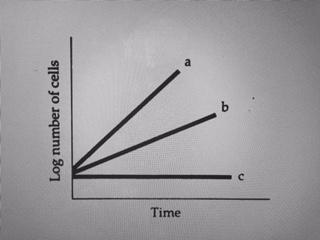
Which line shows the growth of an obligate aerobe incubated anaerobically?
C
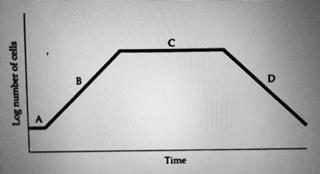
Where would an antibiotic that inhibits bacterial peptidoglycan synthesis be most effective?
a. A
b. B
c. C
d. D
b. B
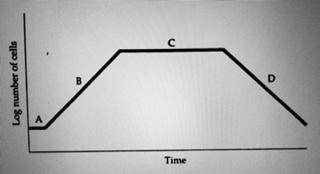
Antibiotics are produced by bacteria when optimal growth conditions begin to deteriorate. During which part of the growth curve would bacteria be secreting antibiotics?
a. A
b. B
c. C
d. D
c. C
What is the best definition of a “pure culture”?
- a culture that contains only one type of microorganism
- a culture that contains only one cellular morphology of bacterium (e.g., rods)
- an agar plate of bacteria that has not been contaminated with mold
- bacterial colonies that are uniform in color
a. a culture that contains only one type of microorganism
What is the desired result of the quadrant streak plate technique?
- cover the entire surface of the agar with a maximum amount of bacterial growth
- determine the quantity of bacteria in the original culture
- obtain growth of only Gram positive cocci
- obtain well isolated bacterial colonies
d. obtain well isolated bacterial colonies
You are attempting to prepare pour plates but your agar deep hardens before you can pour the plate. You can re-melt your agar by putting the agar back into the 50°C waterbath:
- true
- false
b. false
All of the following are true about the enzymes of alkaliphiles EXCEPT that they:
- have an activity optimum at pH above neutral
- will be denatured at lower pH
- are added to laundry detergent
- are found in stomach acid
d. are found in stomach acid
Which of the following microorganisms is an example of a hyperthermophile?
- Chlamydomonas nivalis
- Escherichia coli
- Pyrolobus fumarii
- Staphylococcus aureus
c. Pyrolobus fumarii
Why is molecular oxygen (O2) a toxic molecule for cells?
- it inhibits cellular respiration
- it generates an osmotic potential and causes water to flow into the cell
- free radicals produced during O2 reduction pull electrons off of DNA
- both b and c
c. free radicals produced during O2 reduction pull electrons off of DNA
Which of the following types of organisms possess the enzyme catalase?
- obligate aerobe
- obligate anaerobe
- facultative anaerobe
- both a and c
d. both a and c
Why do temperatures above a microorganism's maximum cause cell death?
- plasma membranes collapse
- nucleic acids denature
- proteins denature
- all of the above
d. all of the above
How are the actions of phenols and alcohols similar as agents that kill microbes?
- both denature proteins
- both oxidize DNA
- both inhibit nucleic acid synthesis
- all of the above
a. both denature proteins
All of the following organisms are correctly matched with their source of energy EXCEPT:
- phototroph – light
- autotroph – CO2
- lithotroph – FeS
- organotroph – glucose
b. autotroph – CO2
Why can't oxidation of glucose to pyruvate be the final stage in glucose catabolism?
- it does not produce enough energy for bacteria to grow
- it does not allow for re-oxidation of NADH to NAD+
- because pyruvate is toxic
- all of the above
b. it does not allow for re-oxidation of NADH to NAD+
In an organism that undergoes fermentation, pyruvate may be:
- oxidized in the TCA cycle
- oxidized in the electron transport chain
- oxidized by glycolysis
- reduced to lactic acid
d. reduced to lactic acid
In addition to the 2ATP formed through glycolysis, how many additional ATP are formed during fermentation?
- 0
- 2
- 4
- 26
a. 0
All of the following are necessary for respiration EXCEPT:
- a source of electrons
- electron carriers
- electron transport chain
- oxygen
d. oxygen
Nitrobacter use carbon dioxide as their carbon source and nitrite as their energy source. These bacteria are:
- phototrophic autotrophs
- phototrophic heterotrophs
- chemoorganotrophic autotrophs
- chemolithotrophic autotrophs
d. chemolithotrophic autotrophs
- The Indole test checks for the formation of the product______________ from the amino acid tryptophan while the Voges-Proskauer tests for the production of ____________ from glucose.
- mixed acids; acetoin
- indole; mixed acids
- tryptophanase; mixed acids
- indole; acetoin
e. indole; acetoin
In order for a bacterium to utilize starch it must:
- break the polysaccharide starch into glucose units
- hydrolyze starch outside the bacterial cell
- secrete ammonia
- both a and b
d. both a and b
In the Citrate test, citrate is the:
- carbon source
- electron acceptor
- enzyme
- pH indicator
a. carbon source
Chemoorganotroph
a. Bacillus
b. Bacteroides
c. cyanobacteria
d. E. coli
e. FeS2
f. Glucose
g. Lactic acid bacteria
h. Lactose
i. Staphylococcus aureus
a. Bacillus
b. Bacteroides
c. cyanobacteria
d. E. coli
f. Glucose
g. Lactic acid bacteria
h. Lactose
i. Staphylococcus aureus
Chemolithotroph
a. Bacillus
b. Bacteroides
c. cyanobacteria
d. E. coli
e. FeS2
f. Glucose
g. Lactic acid bacteria
h. Lactose
i. Staphylococcus aureus
e. FeS2
Heterotroph
a. Bacillus
b. Bacteroides
c. cyanobacteria
d. E. coli
e. FeS2
f. Glucose
g. Lactic acid bacteria
h. Lactose
i. Staphylococcus aureus
a. Bacillus
b. Bacteroides
d. E. coli
f. Glucose
g. Lactic acid bacteria
h. Lactose
i. Staphylococcus aureus
Autotroph
a. Bacillus
b. Bacteroides
c. cyanobacteria
d. E. coli
e. FeS2
f. Glucose
g. Lactic acid bacteria
h. Lactose
i. Staphylococcus aureus
c. cyanobacteria
Obligate anaerobe
a. Bacillus
b. Bacteroides
c. cyanobacteria
d. E. coli
e. FeS2
f. Glucose
g. Lactic acid bacteria
h. Lactose
i. Staphylococcus aureus
a. Bacillus
Facultative anaerobe
a. Bacillus
b. Bacteroides
c. cyanobacteria
d. E. coli
e. FeS2
f. Glucose
g. Lactic acid bacteria
h. Lactose
i. Staphylococcus aureus
d. E. coli
i. Staphylococcus aureus
Obligate anaerobe
a. Bacillus
b. Bacteroides
c. cyanobacteria
d. E. coli
e. FeS2
f. Glucose
g. Lactic acid bacteria
h. Lactose
i. Staphylococcus aureus
b. Bacteroides
Coliform
a. Bacillus
b. Bacteroides
c. cyanobacteria
d. E. coli
e. FeS2
f. Glucose
g. Lactic acid bacteria
h. Lactose
i. Staphylococcus aureus
d. E. coli
Mesophile
a. Bacillus
b. Bacteroides
c. cyanobacteria
d. E. coli
e. FeS2
f. Glucose
g. Lactic acid bacteria
h. Lactose
i. Staphylococcus aureus
a. Bacillus
b. Bacteroides
c. cyanobacteria
d. E. coli
e. FeS2
g. Lactic acid bacteria
i. Staphylococcus aureus
Halophile
a. Bacillus
b. Bacteroides
c. cyanobacteria
d. E. coli
e. FeS2
f. Glucose
g. Lactic acid bacteria
h. Lactose
i. Staphylococcus aureus
i. Staphylococcus aureus
Aerobic respiration
a. Bacillus
b. Bacteroides
c. cyanobacteria
d. E. coli
e. FeS2
f. Glucose
g. Lactic acid bacteria
h. Lactose
i. Staphylococcus aureus
a. Bacillus
c. cyanobacteria
d. E. coli
Anaerobic respiration
a. Bacillus
b. Bacteroides
c. cyanobacteria
d. E. coli
e. FeS2
f. Glucose
g. Lactic acid bacteria
h. Lactose
i. Staphylococcus aureus
d. E. coli
Fermentation
a. Bacillus
b. Bacteroides
c. cyanobacteria
d. E. coli
e. FeS2
f. Glucose
g. Lactic acid bacteria
h. Lactose
i. Staphylococcus aureus
b. Bacteroides
d. E. coli
f. Glucose
g. Lactic acid bacteria
h. Lactose
Fecal-oral route of transmission
a. Bacillus
b. Bacteroides
c. cyanobacteria
d. E. coli
e. FeS2
f. Glucose
g. Lactic acid bacteria
h. Lactose
i. Staphylococcus aureus
d. E. coli

In which tube are microaerophiles growing? Select one:
a. a
b. b
c. c
d. d
e. e
e. e

in which tube are facultative anaerobes growing?
Select
one:
a. a
b. b
c. c
d. d
e. e
b. b
In one hospital, Pseudomonas aeruginosa serotype 10 infected the
biliary tract of 10% of 1300 patients who
underwent
gastrointestinal endoscopic procedures. After each use, endoscopes
were washed with an automatic
reprocessor that flushed detergent
and glutaraldehyde through the endoscopes, followed by a tap water
rinse.
P. aeruginosa 10 was not isolated from the detergent,
glutaraldehyde, or tap water. What was the source of the
infections?
a. Bacterial cell walls in the water
b. A biofilm in the reprocessor
c. Contaminated disinfectant
d. Fecal contamination of the bile ducts
b. A biofilm in the reprocessor
Which of the following substances can sterilize?
a. Alcohol
b. Phenolics
c. Ethylene oxide
d. Chlorine
e. Soap
c. Ethylene oxide
Which of the following substances is used for surgical hand scrubs?
a. Phenol
b. Chlorine bleach
c. Chlorhexidine
d. Soap
e. Glutaraldehyde
c. Chlorhexidine
Place the following surfactants in order from the most effective to the least effective antimicrobial activity:
1-Soap; 2-Acid-anionic detergent; 3-Quats.
a. 1, 2, 3
b. 1, 3,
2
c. 2, 1, 3
d. 3, 2, 1
e. 3, 1, 2
d. 3, 2, 1
The antimicrobial activity of chlorine is due to which of the following?
a. The formation of hypochlorous acid
b. The formation of hydrochloric acid
c. The formation of ozone
d. The formation of free O
e. Disruption of the plasma membrane
a. The formation of hypochlorous acid
Iodophors differ from iodine (I2) in that iodophors
a. Don't stain.
b. Are less irritating.
c. Are longer lasting.
d. Are combined with a nonionic detergent.
e. All of the above.
e. All of the above
Which of the following does NOT achieve sterilization?
a. Dry
heat
b. Pasteurization
c. Autoclave
d.
Formaldehyde
e. Ethylene oxide
b. Pasteurization
Which of the following is a limitation of the autoclave?
a. Requires a long time to achieve sterilization
b. Cannot inactivate viruses
c. Cannot kill endospores
d. Cannot be used with heat-labile materials
e. Cannot be used with glassware
d. Cannot be used with heat-labile materials
Which of the following affects the elimination of bacteria from an object?
a. Number of bacteria present
b. Temperature
c. pH
d. Presence of organic matter
e. All of the above
e. All of the above
Which of the following does NOT directly result from application of heat?
a. Breaking of hydrogen bonds
b. Breaking of sulfhydryl bonds
c. Denaturing of enzymes
d. Cell lysis
e. Damage to nucleic acids
d. Cell lysis
Which of these disinfectants acts by denaturing proteins?
A) Alcohols
B) Aldehydes
C) Bisphenols
D) Halogens
E) Phenolics
C) Bisphenols
Which of the following substances is NOT an oxidizing agent?
A) Chlorine
B) Glutaraldehyde
C) Hydrogen peroxide
D) Iodine
E) Ozone
B) Glutaraldehyde
Which of the following is NOT used to disinfect water?
A) Ozone
B) Gamma radiation
C) Chlorine
D) Copper sulfate
E) Heat
E) Heat
Which of the following substances is NOT effective against nonenveloped viruses?
A) Alcohol
B) Chlorine
C) Ethylene oxide
D) Ozone
E) All are equally effective.
A) Alcohol
Glutaraldehyde is considered one of the most effective disinfectants
for hospital use. Which of the following
statements about
glutaraldehyde is false?
A) Stains and corrodes
B) Is safe to transport
C) Acts rapidly
D) Is not hampered by organic material
E) Attacks all microorganisms
A) Stains and corrodes
Which concentration of ethanol is the most effective bactericide?
A) 100%
B) 70%
C) 50%
D) 40%
E) 30%
B) 70%
Which of the following is NOT a factor contributing to hospital-acquired infections?
A) Some bacteria metabolize disinfectants.
B) Gram-negative bacteria are often resistant to disinfectants.
C) Invasive procedures can provide a portal of entry for bacteria.
D) Bacteria may be present in commercial products such as mouthwash.
E) All of the above may contribute to hospital-acquired infection.
E) All of the above may contribute to hospital-acquired infection.
Which of the following treatments is the most effective for controlling microbial growth?
A) 63°C for 30 min.
B) 72°C for 15 sec.
C) 140°C for 4 sec.
D) They are equivalent treatments.
E) None is effective.
D) They are equivalent treatments.
Which of the following could be used to sterilize plastic Petri plates in a plastic wrapper?
A) Autoclave
B) Gamma radiation
C) Microwaves
D) Sunlight
E) Ultraviolet radiation
B) Gamma radiation
Which of the following pairs is mismatched?
A) Ag--burns
B) Alcohols--open wounds
C) CuSO4--algicide
D) H2O2--open
wounds
E) Organic acids--food preservation
B) Alcohols open wounds
Which one of the following does NOT belong with the others?
A) Acid-anionic detergents
B) Benzoic acid
C) Supercritical CO2
D) Pasteurization
E) Peracetic acid
A) Acid-anionic detergents
Which one of the following does NOT belong with the others?
A) Beta-propiolactone
B) Glutaraldehyde
C) Ethylene oxide
D) Hydrogen peroxide
E) Propylene oxide
D) Hydrogen peroxide
Which of the following substances is NOT used to preserve foods?
A) Biguanides
B) Nisin
C) Potassium sorbate
D) Sodium nitrite
E) Sodium propionate
A) Biguanides
Which of the following will NOT destroy prions?
A) Boiling
B) Incineration
C) NaOH + autoclaving at 134°C
D) Proteases
E) All of the above destroy prions.
A) Boiling
Which one of the following pairs is mismatched?
A) Ionizing radiation-- hydroxyl radicals
B) Ozone -- takes electrons from substances
C) Plasma sterilization-- free radicals
D) Supercritical fluids-- CO2
E) Ultraviolet radiation --desiccation
E) Ultraviolet radiation --desiccation
Which of the following will NOT preserve foods?
A) Desiccation
B) High pressure
C) Ionizing radiation
D) Microwaves
E) Osmotic pressure
D) Microwaves
Which of the following will NOT inactivate endospores?
A) Autoclave
B) Chlorine dioxide
C) High pressure
D) Plasma
E) Supercritical CO2
C) High pressure
If you were preparing nutrient agar at home and didn’t have an
autoclave, what could you use to sterilize the
nutrient agar?
A) Bleach
B) Boiling for 1 hour
C) Hydrogen peroxide
D) Oven at 121°C for 1 hour
E) Pressure cooker at 121°C for 15 minutes
E) Pressure cooker at 121°C for 15 minutes
Bone and tendons for transplant are decontaminated by
A) Ethylene oxide.
B) Glutaraldehyde.
C) Peroxygens.
D) Plasma sterilization.
E) Supercritical fluids.
E) Supercritical fluids.
Which one of the following is most resistant to chemical biocides?
A) Gram-negative bacteria
B) Gram-positive bacteria
C) Mycobacteria
D) Protozoan cysts
E) Viruses with lipid envelopes
C) Mycobacteria
Which of the following pairs is mismatched?
A)DNA gyrase--coils and twists DNA
B)DNA ligase--joins segments of DNA
C)Transposase--insertion of DNA segments into DNA
D)RNA polymerase--makes a molecule of RNA from an RNA template
E)DNA polymerase--makes a molecule of DNA from a DNA template
D)RNA polymerase--makes a molecule of RNA from an RNA template
DNA is constructed of
A)Two strands of nucleotides running antiparallel.
B)Nucleotides bonded A&C and G&T.
C)A single strand of nucleotides with internal hydrogen bonding.
D)Two strands of identical nucleotides with hydrogen bonds between them.
E)None of the above.
A)Two strands of nucleotides running antiparallel.
Which of the following statements about bacteriocins is false?
A)They can be used to identify certain bacteria.
B)Bacteriocins kill baceria.
C)The genes coding for them are on plasmids.
D)They cause food-poisoning symptoms.
E)Nisin is a bacteriocin used as a food preservative.
D)They cause food-poisoning symptoms.
When glucose is high, cAMP is ________ : CAP ________ bind the lac operator, and RNA polymerase ________ bind the lac promoter.
A) low, doesn’t, doesn’t
B) high, doesn’t, does
C) low, doesn’t, doesn’t
D) low, does, does
E) high, does, does
D) low, does, does
Genetic change in bacteria can be brought about by
A)Conjugation.
B)Transduction.
C)Transformation.
D)Mutation.
E)All of the above.
E)All of the above.
The initial effect of ionizing radiation on a cell is that it causes
A)Base substitutions.
B)The formation of highly reactive ions.
C)Bonding between adjacent thymines.
D)DNA to break.
E)The cells to get hot.
B)The formation of highly reactive ions.
Synthesis of a repressible enzyme is stopped by
A)The substrate binding to the repressor.
B)The end-product binding to the promoter.
C)The allosteric transition.
D)The corepressor binding to the operator.
E)The corepressor-repressor binding to the operator.
E)The corepressor-repressor binding to the operator.
The mechanism by which the presence of glucose inhibits the arabinose operon is
A)Translation.
B)DNA polymerase.
C)Induction.
D)Repression.
E)Catabolite repression.
E)Catabolite repression.
An enzyme that makes covalent bonds between nucleotide sequences in DNA is
A)RNA polymerase.
B)Transposase.
C)Restriction enzyme.
D)DNA ligase.
E)DNA polymerase.
D)DNA ligase.
An enzyme that cuts double-stranded DNA at specific nucleotide sequences.
A)DNA ligase
B)DNA polymerase
C)Transposase
D)Restriction enzyme
E)RNA polymerase
D)Restriction enzyme
Repair of damaged DNA might be viewed as a race between an endonuclease and
A)DNA ligase.
B)Helicase.
C)Primase.
D)DNA polymerase.
E)Methylase.
E)Methylase.
E. coli makes insulin because
A)It's an ancient gene that now has no function.
B)The insulin gene was inserted into it.
C)It picked up the insulin gene from another cell.
D)It needs to regulate its cell-glucose level.
E)No reason; it doesn't make insulin.
B)The insulin gene was inserted into it.
Which of the following methods of making rDNA could be described as "hit or miss"?
A)Protoplast fusion
B)Gene gun
C)Transformation
D)Cloning
E)Viral transduction
A)Protoplast fusion
PCR can be used to amplify DNA in a clinical sample. The following steps are used in PCR. What is the fourth step?
A)Incubate at 72°C.
B)Collect DNA.
C)Add DNA polymerase.
D)Incubate at 94°C.
E)Incubate at 60°C.
E)Incubate at 60°C.
The following steps must be performed to make a bacterium produce
human protein X:
1-Translation; 2-Restriction enzyme;
3-Prokaryotic transcription; 4-DNA ligase; 5-Transformation;
6-Eukaryotic transcription; 7-Reverse transcription.
Put the
steps in the correct sequence.
A)1, 2, 3, 5, 4, 7, 6
B)6, 7, 2, 3, 4, 5, 1
C)6, 7, 2, 4, 5, 3, 1
D)6, 2, 1, 3, 4, 5, 7
E)5, 2, 3, 4, 7, 6, 1
C)6, 7, 2, 4, 5, 3, 1
A specific gene can be inserted into a cell by all of the following EXCEPT
A)Protoplast fusion.
B)Agrobacterium.
C)Electroporation.
D)A gene gun.
E)Microinjection.
A)Protoplast fusion.